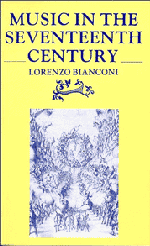SOURCE READINGS
Published online by Cambridge University Press: 01 June 2011
Summary
A musical banquet: Florence, 1608
Following a centuries-old tradition, music continued in the Seicento to represent an element of not inconsiderable importance as an adjunct to the greatest, most prestigious and memorable banquets. Reproduced by way of example (and not without a number of cuts in the enormous menu) in the following pages is the order of the banquet given by the Grand Duke of Tuscany on 19 October 1608 in the Salone dei Cinquecento of the Palazzo Vecchio, Florence, in celebration of the marriage of Crown Prince Cosimo II. The description – originally published by the celebrated cook Vittorio Lancellotti da Camerino in his no less authoritative treatise on banquets, Lo scalco prattico (Rome, 1627) – is interesting in several respects. As in the banquets of sixteenth-century Ferrara (see Rivisia italiana di musicologia, X (1975), 216ff.), the musical interludes between the various courses function as true entremets: moments of relief and entertainment for the senses, which act as both pauses and links between the different phases of convivial pleasure. The exuberant sixteenth-century agglomeration of sundry musical offerings, however, is here replaced by the overall organization of homogeneous musical interludes which finally converge in the apotheosis of the concluding grand ‘concerto’ (over 150 performers, in the words of one eyewitness): allegorical characters appear and recede on a series of self-propelling machines in songful homage to bride, groom and dynasty.
- Type
- Chapter
- Information
- Music in the Seventeenth Century , pp. 265 - 326Publisher: Cambridge University PressPrint publication year: 1987

